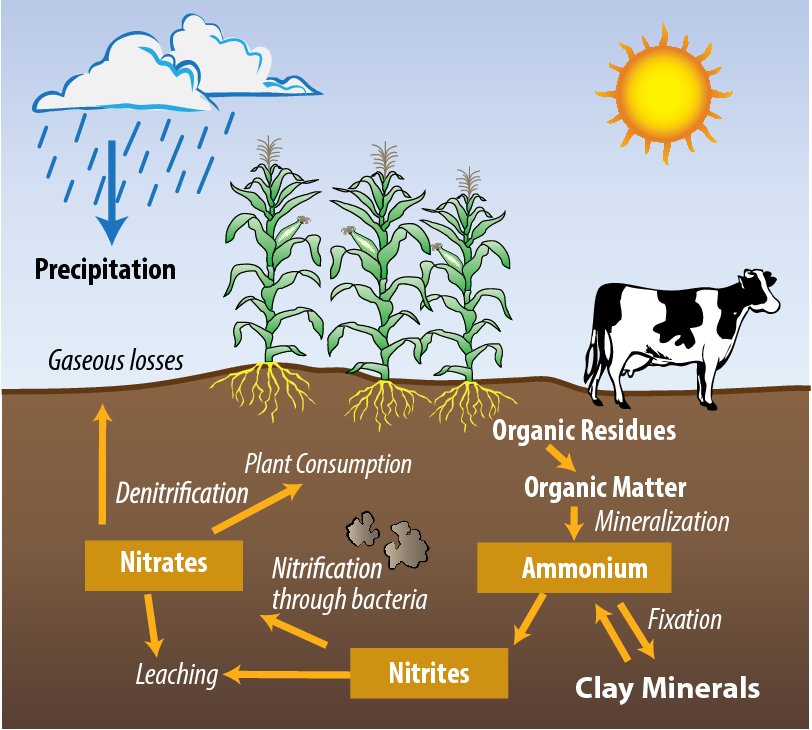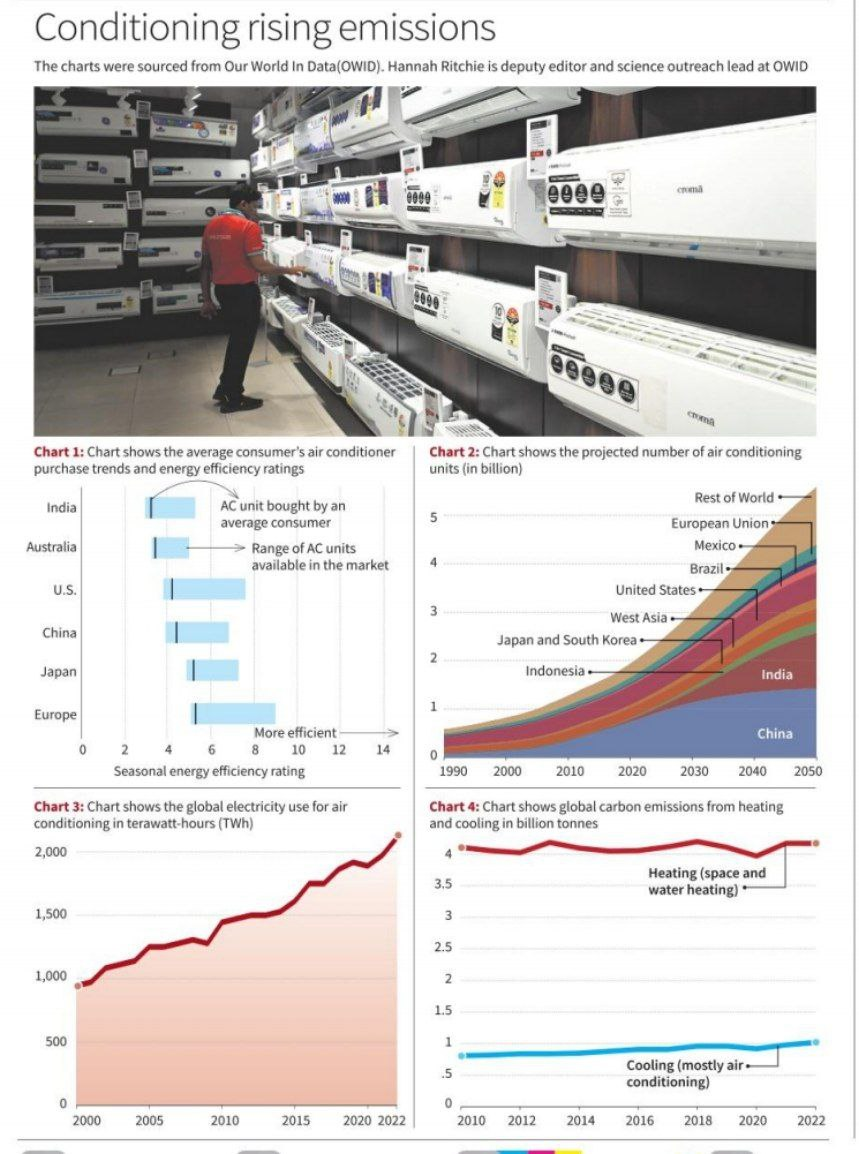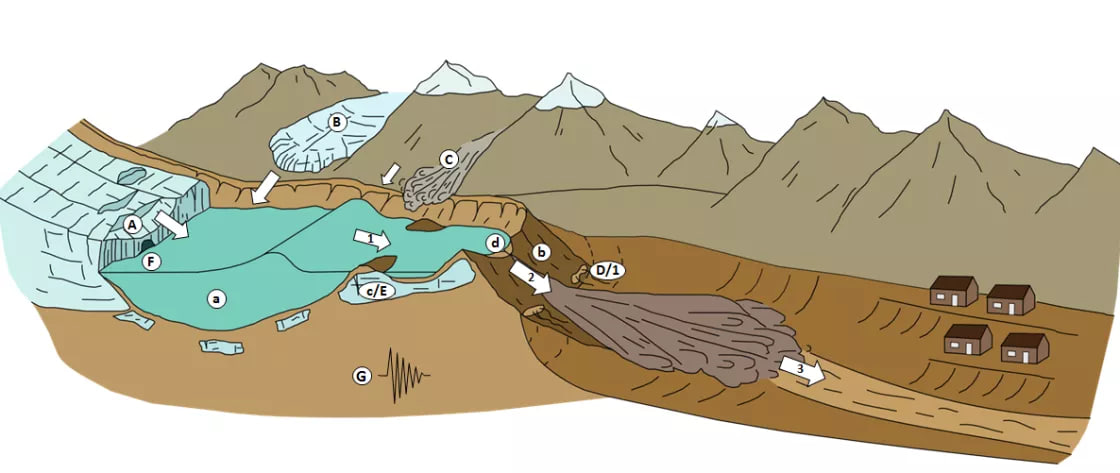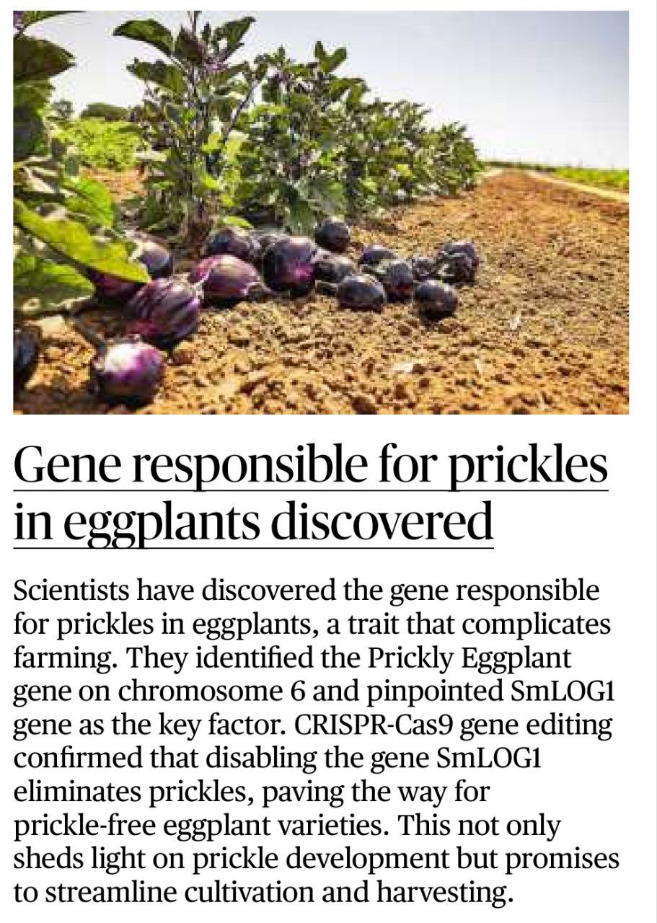1. Findings on Nitrogen Use Efficiency (NUE) in Rice Varieties
Key Discovery:
- Institution: Guru Gobind Singh Indraprastha University (GGU), New Delhi
- Publication: Journal of Plant Growth Regulation
Findings:
- Variation in NUE: Significant variation found among popular rice varieties in India regarding their ability to use nitrogen.
- Efficiency Range: Best-performing varieties showed NUE five times greater than the least efficient ones.
- Implications: This discovery can help develop rice varieties that use less nitrogen, leading to reduced fertilizer costs and decreased nitrogen-linked pollution.
Current Situation:
- Urea Consumption: Cereals, particularly rice, consume two-thirds of all urea in India.
- Financial Impact: Poor NUE results in wastage of nitrogen fertilizers worth approximately ₹1 trillion annually in India and over $170 billion globally.
- Environmental Impact: Nitrogen fertilizers are major sources of nitrous oxide, ammonia pollution, and water pollution, impacting health, biodiversity, and climate change.
Agricultural Practices:
- Traditional focus has been on increasing yields which led to excessive use of synthetic fertilizers, causing wastage and environmental harm.
- Improvement in NUE is crucial but has not been a significant focus for crop improvement due to the dominant emphasis on yield maximization.
Recommendations:
- Broader Approach Needed: To enhance NUE and yields, a broader approach incorporating various rice varieties should be adopted.
Biotechnology’s Role: While improvements in fertilizer formulations, crop rotations, and management practices are beneficial, there is a pressing need to focus on enhancing NUE through biotechnology.
2. Air Conditioning Trends and Impact
Key Points:
- Consumer Behavior and Efficiency:
- IEA Analysis: Average consumers tend to purchase less efficient air conditioning (AC) units.
- Efficiency Range: Globally, AC units bought are approximately half as efficient as those available in stores.
- Cost Barrier: Higher upfront costs of more efficient models deter consumers. For example, in India, a 3-star rated AC costs around ₹29,000, while a 5-star rated one costs about ₹36,000.
- Global Trends and Projections:
- AC Units Growth: The number of global AC units is projected to increase from 2 billion in 2022 to over 5.5 billion by 2050.
- Regional Dominance: By 2050, China and India are expected to have over 45% of the total AC units globally.
- Impact of Climate Change and Rising Incomes:
- Climate Change: Increased global temperatures and more intense heat waves drive higher demand for AC units.
- Income Growth: Rising incomes in hot countries lead to increased AC purchases.
- Energy Consumption and Emissions:
- Electricity Use: In 2022, air conditioning consumed about 2,100 terawatt-hours (TWh) of electricity, representing 7% of global electricity use.
- Growth Rate: Electricity demand for ACs has more than doubled since 2000.
- CO2 Emissions: AC units were responsible for about 1 billion tonnes of CO2 emissions in 2022 (2.7% of total CO2 emissions). Including refrigerants, emissions rise to 3.2% of all greenhouse gases.
- Comparison with Heating:
- Emissions: The emissions from AC units are lower than those from space and water heating.
- Health Benefits:
- Impact on Health: ACs are crucial for heat tolerance, with estimates suggesting they prevented around 200,000 premature deaths in 2019.
Policy and Practical Implications:
- Policy Recommendations:
- Incentivize Efficiency: Implement policies to make energy-efficient AC units more affordable and accessible.
- Promote Energy Efficiency: Increase awareness and incentives for purchasing high-efficiency AC units.
- Environmental Considerations:
- Reduce Emissions: Encourage technologies and policies to reduce emissions from both electricity use and refrigerants in AC units.
- Adaptation Measures: Develop and promote alternative cooling solutions and climate adaptation strategies.
- Health and Safety:
Balance Needs: Recognize the role of AC in improving health outcomes and mitigating heat-related risks, while addressing environmental concerns.
3. Rising Glacial Lakes in Himachal Pradesh and Tibet
Key Findings:
- Increase in Glacial Lakes:
- Study Period: 2019 to 2023
- Region: Satluj river catchment area (from upstream Jhakri to Mansarover Lake in Tibet)
- Data: The number of glacial lakes has nearly doubled, increasing from 562 in 2019 to 1,048 in 2023.
- Lake Size Distribution:
- Small Lakes (<5 hectares): 900 lakes
- Medium Lakes (5-10 hectares): 89 lakes
- Large Lakes (>10 hectares): 59 lakes
- Climate Change Impact:
- Melting Glaciers: Rapid reduction in glacier sizes is causing the formation of these lakes.
- Temperature Trends: Higher altitude areas (Tibetan Himalayas) are experiencing faster warming compared to lower regions, leading to an increase in smaller lakes.
- Regional Differences:
- Upper Satluj Basin: Higher number of lakes compared to the Spiti and Lower Satluj basins.
- Implication: Greater susceptibility to glacial lake formation in the Upper Satluj basin indicates a more significant impact of climate change in higher altitudes.
- Downstream Threats:
- Potential Hazards: The rise in glacial lakes poses a risk of catastrophic outbursts, which could endanger downstream habitations and infrastructure.
- Instability Factors: Factors contributing to instability include increased water volume and calving effects of adjoining glaciers, which can lead to avalanches or lake breaches.
- Expert Insights:
- S. Randhawa (HIMCOSTE): The increase in small lakes reflects the significant effects of climate change in higher Himalayan regions.
- Sunil Dhar (Central University of Jammu): The growth of these lakes and their potential instability due to climate-induced changes are concerning for downstream safety and infrastructure.
Policy and Practical Implications:
- Disaster Preparedness:
- Risk Assessment: Implementing comprehensive risk assessments for areas downstream of glacial lakes.
- Early Warning Systems: Establishing and improving early warning systems for potential glacial lake outburst floods (GLOFs).
- Climate Action:
- Mitigation Strategies: Developing strategies to mitigate climate change impacts and manage glacier melt.
- Research and Monitoring: Continued monitoring and research to understand glacier dynamics and lake stability.
- Infrastructure Planning:
- Resilient Design: Designing infrastructure to withstand potential impacts of GLOFs and other climate-related hazards.
- Community Awareness: Educating communities about the risks associated with glacial lakes and preparedness measures.
- Policy Recommendations:
- Integrated Approach: Adopting an integrated approach that combines climate science, environmental management, and disaster risk reduction.
International Cooperation: Collaborating with neighbouring regions and countries to address trans boundary impacts and share best practices.
4. Release of New Crop Varieties
Event Overview:
- Date: August 11, 2024
Details of the Released Varieties:
- Total Varieties: 109
- Crops Covered: 61 crops
- Categories:
- Field Crops: 34 varieties including cereals (millets, oilseeds), forage crops, pulses, sugarcane, cotton, fibre, and other potential crops.
- Horticultural Crops: 27 varieties including fruits, vegetables, plantation crops, tuber crops, spices, flowers, and medicinal crops.
Key Highlights:
- High-Yield and Climate-Resilience:
- The released varieties are designed to be high-yielding, climate-resilient, and biofortified, aiming to enhance agricultural productivity and sustainability.
- Farmer and Scientist Interaction:
- Discussion Topics:
- Value Addition in Agriculture: The importance of enhancing agricultural value through improved crop varieties.
- Millets: Emphasis on the benefits of millets, which are highlighted for their nutritional and climate-resilient properties.
- Natural and Organic Farming: Discussion on the role of natural farming and growing interest in organic farming practices.
- Discussion Topics:
- Krishi Vigyan Kendras (KVKs):
- Role in Awareness: KVKs play a crucial role in disseminating information about new crop varieties to farmers.
- Recommendation: Prime Minister suggested that KVKs should actively inform farmers about the benefits of new varieties developed regularly to boost awareness and adoption.
Significance and Implications:
- Agricultural Productivity and Sustainability:
- High-Yield Varieties: These new varieties aim to improve crop yields, addressing food security and farmers’ income.
- Climate Resilience: Development of varieties that can withstand climate stressors helps in adapting agriculture to changing environmental conditions.
- Nutritional Benefits:
- Biofortification: Crops are enriched with essential nutrients, contributing to improved public health and nutrition.
- Economic Impact:
- Reduced Expenditure: By enhancing productivity and resilience, these varieties can reduce input costs and increase profitability for farmers.
- Educational and Extension Support:
- KVKs: Strengthening the role of KVKs ensures effective dissemination of agricultural innovations and practices to the farming community.
- Promotion of Organic Farming:
- Natural Farming Practices: Encouraging organic and natural farming aligns with sustainable agricultural practices and growing consumer demand for organic products.
Policy and Practical Recommendations:
- Support for Farmers:
- Training Programs: Implement training and support programs to help farmers transition to new crop varieties and farming practices.
- Incentives: Provide incentives for adopting high-yield and climate-resilient varieties.
- Infrastructure Development:
- Extension Services: Enhance extension services and infrastructure to facilitate the distribution and use of new crop varieties.
- Research and Development:
- Ongoing Innovation: Continue research to develop and improve crop varieties that address emerging agricultural challenges.
- Public Awareness:
Educational Campaigns: Launch awareness campaigns to educate farmers about the benefits of new varieties and sustainable farming practices.
5. Release of New Cardamom Varieties
Event Overview:
- Date and Location: The new cardamom varieties were released by Prime Minister Narendra Modi in Delhi.
- Institution: Indian Institute of Spices Research (IISR), Kozhikode, a part of the Indian Council of Agricultural Research (ICAR).
- Regional Station: IISR regional station at Appangala, Madikeri, Karnataka.
New Varieties Developed:
- IISR Manushree:
- Development Method: Clonal selection.
- Drought Tolerance: Suitable for moisture-stress conditions.
- Yield:
- Under Irrigated Conditions: 550 kg of capsules per hectare (ha).
- Under Moisture-Stress Conditions: 360 kg per ha.
- Essential Oil Content:
- Under Irrigated Conditions:74%.
- Under Moisture-Stress Conditions:84%.
- Cultivation Suitability: Karnataka and Kerala.
- IISR Kaveri:
- Development Method: Clonal selection.
- Drought Tolerance: Suitable for moisture-stress conditions.
- Yield:
- Under Irrigated Conditions: 482 kg of capsules per ha.
- Under Moisture-Stress Conditions: 308 kg per ha.
- Essential Oil Content:
- Under Irrigated Conditions:08%.
- Under Moisture-Stress Conditions:51%.
- Cultivation Suitability:
Significance and Implications:
- Drought Tolerance:
- Importance: Both varieties are developed to withstand moisture stress, addressing a critical challenge in cardamom cultivation.
- Impact: This development is crucial as soil moisture limitations are a significant barrier in enhancing cardamom production, especially in non-traditional growing areas.
- Yield and Essential Oil Content:
- IISR Manushree and IISR Kaveri provide options for farmers facing variable moisture conditions, potentially improving yield stability and essential oil content in diverse environmental conditions.
- Encouraging Cultivation:
- Non-Traditional Areas: The introduction of drought-tolerant varieties may stimulate interest in cardamom cultivation in regions previously affected by moisture stress, thereby expanding the crop’s geographical footprint.
- Regulatory Approval:
- Status: Both varieties received approval from the Central Sub-Committee on Crop Standards, Notification, and Release of Varieties for Horticultural Crops, making them officially recognized for cultivation.
Policy and Practical Recommendations:
- Support for Farmers:
- Training and Awareness: Educate farmers in traditional and non-traditional areas about the benefits of these new varieties.
- Financial Incentives: Provide subsidies or financial support for farmers to adopt these drought-tolerant varieties.
- Research and Development:
- Continued Innovation: Encourage ongoing research to develop more varieties with enhanced traits suited to changing climatic conditions.
- Climate Adaptation:
- Resilience Building: Integrate these new varieties into broader climate adaptation strategies for agriculture, focusing on crops that can withstand environmental stress.
- Infrastructure Improvement:
Water Management: Improve irrigation infrastructure to complement the drought-resistant traits of the new cardamom varieties.
6. Hidden Dangers of Irrational Antibiotic Use on the Microbiome
Overview:Antibiotics, while life-saving, have hidden dangers beyond antimicrobial resistance (AMR). Irrational use of antibiotics, especially broad-spectrum ones, can severely disrupt the microbiome—a complex community of microorganisms essential for various bodily functions.
Key Concepts:
- Microbiome and Its Functions:
- Microbiome Composition: The human body hosts approximately 38 trillion microbial cells, surpassing human cells.
- Roles of Gut Microbiome:
- Digestion: Aids in breaking down food.
- Nutrient Production: Produces vitamins like K and B.
- Immune Support: Enhances immune system function.
- Protection: Shields against harmful pathogens.
- Impact of Antibiotics:
- Disruption (Dysbiosis): Antibiotics, particularly broad-spectrum, kill both harmful and beneficial bacteria, leading to dysbiosis. This imbalance can have significant health implications.
- Effects of Dysbiosis:
- Gut Health: Can cause inflammatory bowel disease, irritable bowel syndrome, and impaired digestion.
- Immune System: Weakens immune responses, increasing susceptibility to infections and autoimmune diseases.
- Metabolic Processes: Affects energy harvesting, glucose regulation, and lipid metabolism, contributing to obesity, diabetes, and metabolic syndrome.
- Systemic Effects:
- Gut-Brain Axis: Dysbiosis can alter neurotransmitter levels, impacting mood, cognition, and mental health conditions like anxiety and depression.
- Gut-Liver Axis: Increased gut permeability (“leaky gut”) can exacerbate liver conditions such as non-alcoholic fatty liver disease.
- Gut-Skin Axis: Can worsen skin conditions like acne, eczema, and psoriasis.
- Other Microbiomes:
- Respiratory Tract: Disruption can lead to respiratory issues like asthma.
- Genitourinary Tract: May cause infections such as bacterial vaginosis and urinary tract infections.
- Colonisation Resistance:
- Definition: The microbiome’s ability to prevent pathogenic microorganisms from establishing themselves.
- Impact of Antibiotics: Reduces colonisation resistance, increasing the risk of infections by allowing harmful bacteria to proliferate.
- Alternatives and Recommendations:
- Alternative Practices: Emphasize better hygiene, vaccination, and the use of bacteriophages.
- Judicious Use: Avoid unnecessary antibiotic use and select antibiotics carefully to preserve microbiome balance.
- Medicine-Poison Paradox:
- Concept: Antibiotics are essential and life-saving when used appropriately but can act as “poisons” if misused, disrupting the microbiome and causing health issues.
Policy and Practical Recommendations:
- Antibiotic Stewardship:
- Guidelines: Implement and adhere to guidelines for appropriate antibiotic use to minimize dysbiosis.
- Education: Educate healthcare providers and the public about the risks of irrational antibiotic use and the importance of microbiome health.
- Research and Innovation:
- Develop Alternatives: Invest in research for alternatives to antibiotics, such as bacteriophages and improved hygiene practices.
- Microbiome Studies: Enhance studies on the microbiome to understand better the impacts of antibiotics and develop strategies to mitigate negative effects.
- Health Systems:
- Monitoring: Establish systems for monitoring antibiotic use and its impact on health outcomes.
Support: Provide support for implementing practices that reduce reliance on antibiotics.
7. Environmentalists Call for Inclusion of ESAS in Draft Coastal Zone Management Plan
CONTEXT:
Environmentalists are raising concerns about the draft Coastal Zone Management Plans (CZMP) published by the Puducherry Pollution Control Committee (PPCC).
The draft is criticized for not aligning with the amended Coastal Regulation Zone (CRZ) Notification of 2019, specifically in its handling of Ecologically Sensitive Areas (ESAs).
Key Issues:
- Incomplete Mapping:
- Concerns: The draft CZMP lacks accurate delineation of ESAs, crucial for protecting coastal ecosystems and the livelihoods of local fisherfolk.
- Mapping Efforts: The Coastal People’s Right to Life Movement (CPRM) conducted GIS mapping to identify areas omitted from the PPCC’s draft. Their findings highlight significant gaps, including:
- Mangroves: The National Centre for Sustainable Coastal Management (NCSCM) identified only 82.64 acres of mangroves, missing an additional 228 acres.
- Sand Dunes: Only 45.78 acres were marked in Puducherry, with no sand dunes listed in Karaikal. CPRM’s study shows around 355.19 acres of existing sand dunes are not included.
- Impact on Fisher folk:
- Community Concerns: The draft CZMP fails to include fishing villages and does not account for future development needs of fisher communities.
- Local Advocacy: Fisher panchayats and local federations, alongside CPRM, have been campaigning for accurate and inclusive mapping to ensure the needs of coastal communities are met.
- Ecologically Sensitive Areas (ESAs):
- CRZ-1A Categories: The CRZ notification lists important ESAs, such as:
- Mangroves
- Coral Reefs
- Sand Dunes
- Mudflats
- Sea Grass Beds
- Turtle Nesting Grounds
- Role of ESAs: These areas provide critical environmental functions, such as acting as natural barriers to storms and protecting coastal biodiversity.
- CRZ-1A Categories: The CRZ notification lists important ESAs, such as:
Calls to Action:
- Map Revision:
- Inclusion of Missing ESAs: Environmentalists demand that the missing ESAs be added to the CZMP, including accurate representations of mangroves, sand dunes, and other key areas.
- Community Involvement: Accurate mapping should involve local knowledge and support from communities directly affected by the coastal management plan.
- Proactive Role of Authorities:
- Regulatory Oversight: The Coastal Zone Management Authority for Puducherry and Karaikal should ensure that the PPCC and NCSCM incorporate the missing ESAs and develop a comprehensive conservation plan.
Legal Action: Advocates, including petitioner N. Malayalathan, emphasize the need for legal intervention to ensure that the draft CZMP meets regulatory and environmental standards.








